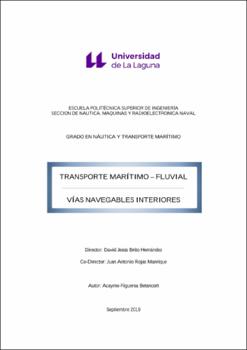Transporte marítimo fluvial: vías navegables interiores
Fecha
2020Resumen
El transporte marítimo fluvial, sus vías interiores o canales que conectan mares, ciudades
y culturas han dado un giro completo a su forma de ser y de existir para decenas de miles
de personas en distintos continentes, países y ciudades.
El transporte marítimo fluvial ha existido desde hace décadas, siendo en muchos países,
en esa época, la única forma de transporte para recoger alimentos, vender estos en otras
ciudades y de forma general un medio para subsistir.
Sin embargo, esta forma de transporte ha ido cogiendo peso y forma en cuanto a: su
influencia comercial, sus conexiones entre puertos de gran importancia en Europa así
como de sus infraestructuras.
No obstante de la misma forma que su evolución fue notable la evolución en este modo
de transporte parece no tener un punto y final ya que de la misma forma que los buques
se desarrollan y crecen en dimensiones, las esclusas, canales y en sí las conexiones en las
arterias internas del centro de Europa así como las conexiones entre mares y ríos deben
mantener y mejorar las condiciones con el fin de seguir recibiendo a los buques en sus
puertos interiores.
A pesar de ser la sombra y no destacar respecto al transporte por vías marítimas, se ha
abierto un espacio que merece ser desglosado y estudiado, por ello y porque he podido
recalar durante algunos meses en una de las rías del sur de España durante mis prácticas
me he decidido a mostrar a continuación esta modo de transporte en las siguientes páginas
y en dos partes bien diferenciadas.
Un primer bloque será aspectos generales y un segundo que mostrará aspectos más
técnicos. The river maritime transport, its interior roads or channels that connect seas cities and
cultures, have completely changed the way of being and existing for tens of thousands of
people in different continents, countries and cities.
River shipping has existed for decades and, in many countries, it has practically been the
only form of transportation to get and sell food and goods. In synthesis, a means to
survive.
However, this mean of transport has become more important with respect at its
commercial influence, its connections between European ports of great importance, as
well as its infrastructure. In addition, in the same way that its constant change is
remarkable, this mean of transport seems to undergo a constant evolution given that, as
the ships develop and become bigger, the locks, channels and the connections in the
internal arteries of central Europe and between seas and rivers must be continuously
maintained and improved in order to continue receiving ships in their inland ports. Despite being in the shadow and not as important as the transport by sea, a space has been
opened that deserves to be broken down and studied. For this reasons, and because I have
had the opportunity to land for some months in one of the estuaries of southern Spain
during my internship, I have decided to study this means of transport, as it will be shown
in the following pages.
This work is divided in two distinct part. The first part will be of general aspects, while
the second one will be centred in more technical aspects.





